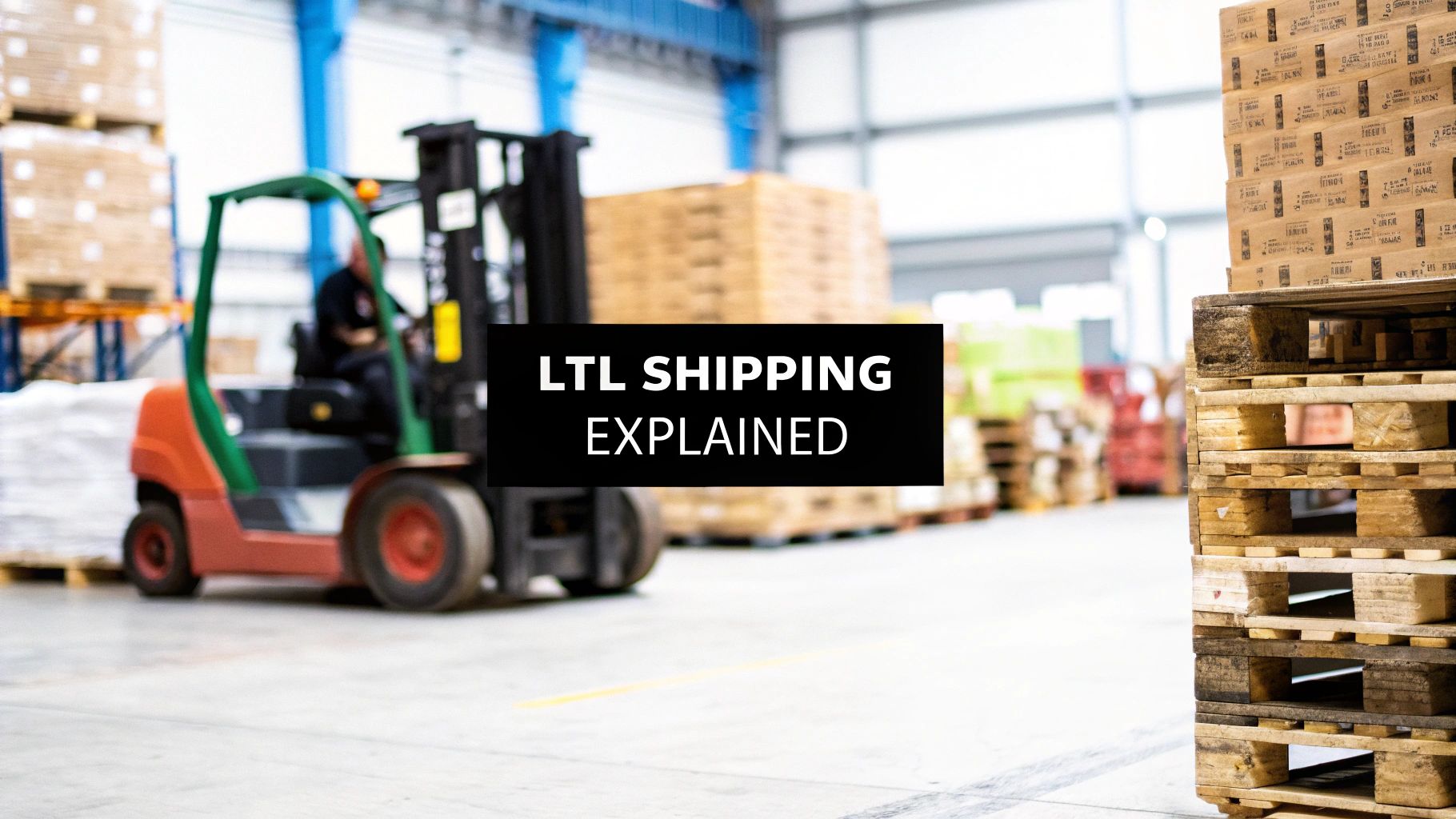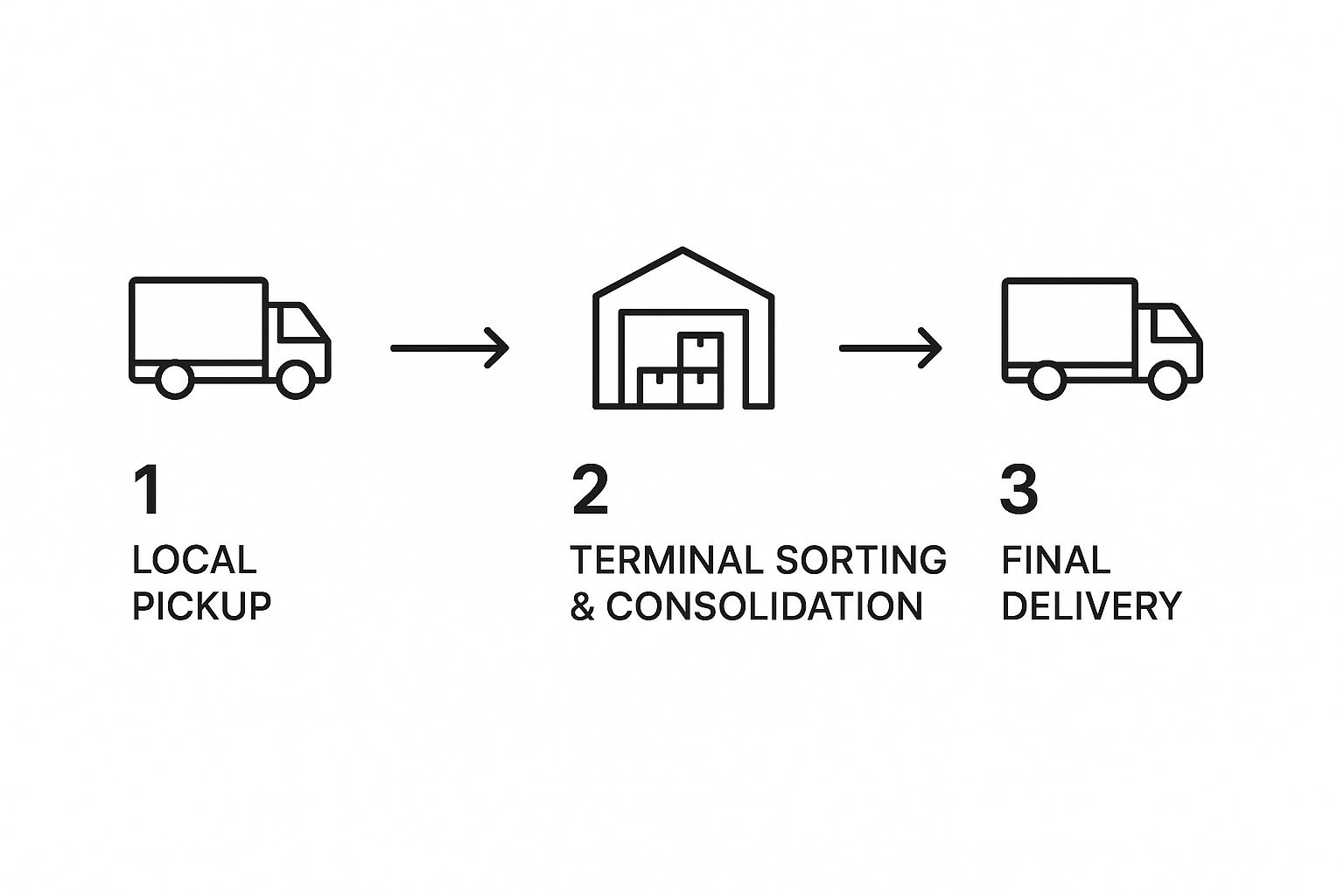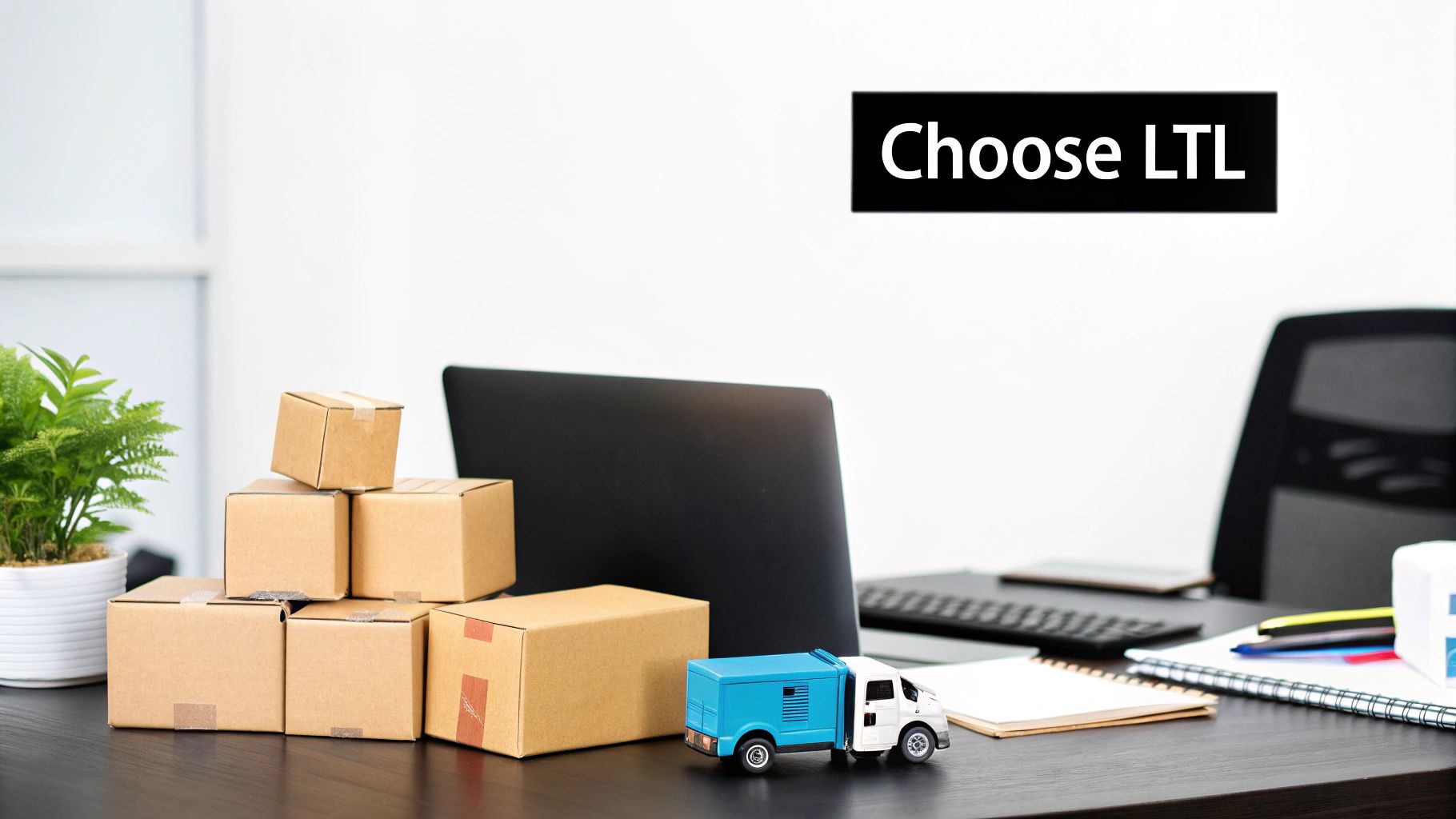Wondering what does LTL mean in shipping? Get a simple explanation of Less Than Truckload freight, how it works, and when it's your best choice.

So, you’ve heard the term LTL tossed around and are wondering what it actually means for your business. Let's break it down.
At its core, LTL stands for Less Than Truckload. It's a smart way to ship freight when you don't have enough product to fill an entire semi-truck on your own.
Think of it like carpooling for your cargo. If you needed to get across town, you wouldn't hire an entire bus for yourself, right? You'd share the ride. LTL shipping applies that same logic to freight.
Instead of paying for a whole truck you can't fill, your smaller shipment gets combined with freight from other companies heading in the same general direction. This way, everyone shares the truck space and, more importantly, shares the cost.
This shared-space model is a game-changer for businesses that need to be nimble and keep a close eye on their shipping budget. The advantages are pretty clear:
Typically, LTL is the go-to choice for shipments weighing anywhere between 150 and 15,000 pounds. For a deeper dive, you can explore more details on LTL shipping definitions.
For those who want the quick-and-dirty summary, this table covers the essentials.
This approach makes professional freight shipping accessible and affordable for almost any business.
So, how does your freight actually get from point A to point B with LTL? Let's follow a single pallet on its journey to really understand the process. Think of it like a cross-country road trip for your cargo, but with a few carefully planned stops to keep things efficient. It all comes down to a clever logistics model known as the “hub-and-spoke” system.
The trip starts when a local truck swings by your business to pick up your freight. This is the first "spoke" of the journey. But instead of heading straight for the final destination, the truck takes a short drive to a regional carrier terminal.
This terminal is the central "hub" where all the action happens. Your pallet is unloaded, scanned, and sorted with dozens of other shipments. Then, it’s strategically loaded onto a long-haul truck with other freight going in the same general direction. The goal is to fill that trailer as much as possible.
This infographic gives a great visual breakdown of the whole process.

As you can see, your shipment is handled and moved several times to make the entire network cost-effective. Depending on the distance, your freight might even hop between a few different hubs, getting re-sorted each time before it lands at the terminal in the destination city. To get a better sense of the companies that manage this, you can learn more about what an LTL carrier is and the critical role they play.
By combining shipments at these hubs, carriers reduce the number of half-empty trucks on the road. This is the secret sauce behind LTL's cost savings and its smaller environmental footprint.
Once your pallet arrives at that final terminal, it's loaded onto another local delivery truck—the final "spoke"—for the last mile to the recipient's doorstep. This multi-step process is exactly why LTL is so much cheaper, even if it adds a little more transit time compared to a dedicated truck.

Alright, so you’ve got the basics of LTL shipping down. Now, let’s talk about its bigger sibling, FTL (Full Truckload), and figure out when it makes sense to use one over the other. This isn't just about picking a service; it's a key decision that hinges on your shipment's size, your budget, and how quickly you need it to arrive.
Think of FTL shipping like chartering a private jet. You book the entire truck for your freight alone. The driver picks up your goods and heads straight to the destination—no pit stops, no detours. This direct route means your stuff gets there faster and is handled a lot less, which is a huge plus for fragile or high-value items.
On the flip side, LTL is more like grabbing a seat on a commercial airline. You're sharing the space (and the cost) with other people's shipments. It’s incredibly cost-effective for smaller loads, but just like a flight with a few layovers, your freight will make stops at various terminals. This means longer transit times and more hands on your pallets along the way.
So, how do you decide? A good rule of thumb is that if you're shipping six pallets or less, LTL is almost always going to be your most budget-friendly option. But once you start dealing with larger quantities, or if speed and safety are top priorities, FTL quickly becomes the smarter play.
Let's dig a little deeper into what sets them apart.
Choosing between LTL and FTL isn't just about the price tag. It’s a strategic decision that directly affects your delivery times, the safety of your products, and the overall rhythm of your supply chain.
To make things crystal clear, here’s a simple side-by-side look at the two options.
This table breaks down the main trade-offs to help you see at a glance which service fits your needs.
Ultimately, it comes down to balancing cost, speed, and security. By weighing these factors against your specific shipment, you'll be able to make the right call every time.
When you look beyond the obvious, LTL shipping offers some seriously impressive advantages, especially for businesses on the rise. The first thing everyone notices is the cost savings. It's a game-changer.
You’re no longer paying for an entire truck you can't fill, which is a massive win for your bottom line. This kind of efficiency is why smart companies explore all sorts of modern logistics strategies to reduce shipping costs.
This cost-effectiveness is also fueling huge market growth. The global LTL sector was valued at around USD 216.68 billion in 2023 and is expected to climb to USD 342.09 billion by 2030. That boom tells you just how many businesses are leaning on this model to stay competitive.
But the perks don't stop with your wallet. LTL gives you incredible flexibility. You can send out smaller orders more often, keeping your supply chain lean and quick to react to what your customers want. No more waiting around to build up a full truckload of inventory.
One of the best-kept secrets of LTL is the access you get to special services that many FTL carriers don't offer. These are designed to solve real-world delivery headaches.
Choosing LTL is not just an economic decision; it's a strategic one. It provides the flexibility and specialized services that help smaller businesses compete on a larger scale.
Finally, there's the sustainability angle. By its very nature, LTL is a greener way to ship. Sharing truck space means fewer half-empty trucks are out on the road, which cuts down on emissions and shrinks your company's carbon footprint. It’s a smart move for your business and the planet.

So, how do you know if LTL is the right call for your business? It’s not always obvious, but there are a few tell-tale signs. If you find yourself in any of the situations below, LTL shipping is probably the smart, cost-effective solution you've been looking for.
LTL really hits its stride when your freight is in that "in-between" zone—too large for a standard parcel carrier but not big enough to justify booking an entire truck. Think of it as the perfect middle ground.
For small businesses and e-commerce shops, this can be a game-changer for getting products out the door without torching the budget. Just remember, pairing LTL with good business commercial storage solutions can make managing your inventory before and after shipment a whole lot smoother.
Let's get specific. What does the ideal LTL shipment really look like? Here are the clear signs that LTL is your best bet:
While LTL trucking might only represent about 10% to 15% of the total trucking volume, it plays a crucial role for businesses needing flexible and affordable options for smaller loads.
At the end of the day, recognizing the characteristics of ideal https://www.freightquotesnow.com/blog/ltl-freight-loads helps you make better shipping decisions. If your freight needs tick these boxes, you can confidently go with LTL and keep your logistics lean and your costs down.
LTL pricing isn't just a number pulled out of thin air. There's a method to the madness, and it all comes down to a little thing called freight class. This number is the key to understanding your shipping quote.
The entire system is managed by the National Motor Freight Classification (NMFC), which provides a standardized way for all carriers to classify shipments. To assign a class, carriers look at four specific characteristics of your cargo.
Think of these four factors as the "personality traits" of your shipment. Together, they tell the carrier everything they need to know to handle and price your freight properly.
Density: This is all about how much your shipment weighs for the space it occupies. Imagine a pallet of heavy steel parts versus a pallet of fluffy pillows. The steel is far denser, so it gets a lower (and cheaper) class, while the bulky pillows get a higher one.
Stowability: How well does your shipment play with others? Freight that is uniform, stackable, and non-hazardous is easy to load. Anything oddly shaped, fragile, or regulated is harder to fit in the truck, bumping up its class.
Handling: Does your freight need special care? Standard, durable boxes are a breeze to move with a forklift. But a pallet of delicate electronics or oddly balanced machinery requires more caution and labor, which increases the freight class.
Liability: What's the risk involved? Carriers look at the value of your goods and the likelihood of theft or damage. A shipment of expensive pharmaceuticals carries a lot more liability than a load of scrap metal, so it will have a higher freight class.
Ready to see an instant rate for your freight?
Getting a handle on how freight class is determined is one of the best ways to keep your shipping budget in check.
Jumping into the world of LTL shipping can bring up a few questions. Let's tackle some of the most common ones I hear from shippers so you can feel totally comfortable with the process.
There isn't one single thing that determines your LTL rate—it's more like a recipe with a few key ingredients. The biggest factors are your shipment's weight, its assigned freight class (a number based on how dense and easy-to-handle it is), and the total distance it needs to travel.
Then, you have any extra services you might need. Think of them as à la carte options—if you need a liftgate at delivery or inside pickup, for example, that will be added to your final quote.
In most cases, yes, it takes a bit longer than a dedicated truck. Think of an LTL truck like a local bus—it makes multiple stops. Your freight will likely move between a few terminals to be sorted and consolidated with other shipments heading in the same direction.
This is the trade-off for the cost savings. You're sharing the ride, which saves a lot of money, but it means the journey isn't a straight shot like it is with Full Truckload (FTL).
This is a huge one, and getting it wrong can be costly. Every LTL shipment comes with a basic level of carrier liability. The important thing to know is that it’s limited and often won't cover the full value of your goods.
Liability coverage is based on the freight class and weight, not your product's actual invoice value. If something happens, you might only get a small fraction of what your cargo is actually worth.
That’s where freight insurance comes in. If you want true peace of mind, especially when shipping high-value items, buying separate insurance is the way to go. It’s designed to cover the gap between the carrier’s limited liability and your shipment's full value, making sure you’re protected.